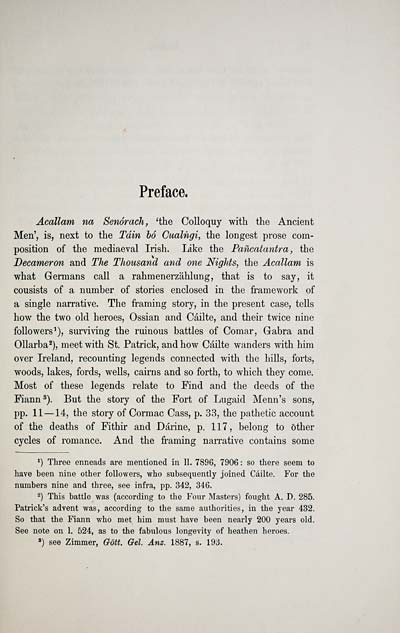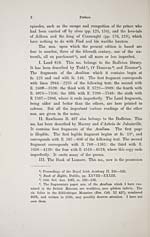Matheson Collection > Irische Texte
(13)
Download files
Complete book:
Individual page:
Thumbnail gallery: Grid view | List view

Preface.
Acallam na Senórach, 'the Colloquy with the Ancient
Men', is, next to the Tain ho Cualngi, the longest prose com-
position of the mediaeval Irish. Like the Paiicatantra , the
Decameron and The Thousand and one Nights, the Acallam is
what Germans call a rahmenerzahlung, that is to say, it
consists of a number of stories enclosed in the framework of
a single narrative. The framing story, in the present case, tells
how the two old heroes, Ossian and Cáilte, and their twice nine
followers'), surviving the ruinous battles of Comar, Gabra and
Ollarba^), meet with St. Patrick, and how Cáilte wanders with him
over Ireland, recounting legends connected with the hills, forts,
woods, lakes, fords, wells, cairns and so forth, to which they come.
Most of these legends relate to Find and the deeds of the
Fiann^). But the story of the Fort of Lugaid Menu's sons,
pp. 11 — 14, the story of Cormac Cass, p. 33, the pathetic account
of the deaths of Fithir and Dáríne, p. 117, belong to Other
cycles of romance. And the framing narrative contains some
*) Three enneads are mentioned in 11. 7896, 7906 : so there seem to
have been nine other followers, who subsequently joined Cáilte. For the
numbers nine and three, see infra, pp. 342, 346.
'^) This battle was (according to the Four Masters) fought A. D. 285.
Patrick's advent was, according to the same authorities, in the year 432.
So that the Fiann who met him must have been nearly 200 years old.
See note on 1. 524, as to the fabulous longevity of heathen heroes.
») see Zimmer, Gott. Gel. Am. 1887, s. 193.
Acallam na Senórach, 'the Colloquy with the Ancient
Men', is, next to the Tain ho Cualngi, the longest prose com-
position of the mediaeval Irish. Like the Paiicatantra , the
Decameron and The Thousand and one Nights, the Acallam is
what Germans call a rahmenerzahlung, that is to say, it
consists of a number of stories enclosed in the framework of
a single narrative. The framing story, in the present case, tells
how the two old heroes, Ossian and Cáilte, and their twice nine
followers'), surviving the ruinous battles of Comar, Gabra and
Ollarba^), meet with St. Patrick, and how Cáilte wanders with him
over Ireland, recounting legends connected with the hills, forts,
woods, lakes, fords, wells, cairns and so forth, to which they come.
Most of these legends relate to Find and the deeds of the
Fiann^). But the story of the Fort of Lugaid Menu's sons,
pp. 11 — 14, the story of Cormac Cass, p. 33, the pathetic account
of the deaths of Fithir and Dáríne, p. 117, belong to Other
cycles of romance. And the framing narrative contains some
*) Three enneads are mentioned in 11. 7896, 7906 : so there seem to
have been nine other followers, who subsequently joined Cáilte. For the
numbers nine and three, see infra, pp. 342, 346.
'^) This battle was (according to the Four Masters) fought A. D. 285.
Patrick's advent was, according to the same authorities, in the year 432.
So that the Fiann who met him must have been nearly 200 years old.
See note on 1. 524, as to the fabulous longevity of heathen heroes.
») see Zimmer, Gott. Gel. Am. 1887, s. 193.
Set display mode to: Large image | Transcription
Images and transcriptions on this page, including medium image downloads, may be used under the Creative Commons Attribution 4.0 International Licence unless otherwise stated. ![]()
| Early Gaelic Book Collections > Matheson Collection > Irische Texte > (13) |
|---|
| Permanent URL | https://digital.nls.uk/76494391 |
|---|
| Description | Items from a collection of 170 volumes relating to Gaelic matters. Mainly philological works in the Celtic and some non-Celtic languages. Some books extensively annotated by Angus Matheson, the first Professor of Celtic at Glasgow University. |
|---|
| Description | Selected items from five 'Special and Named Printed Collections'. Includes books in Gaelic and other Celtic languages, works about the Gaels, their languages, literature, culture and history. |
|---|

